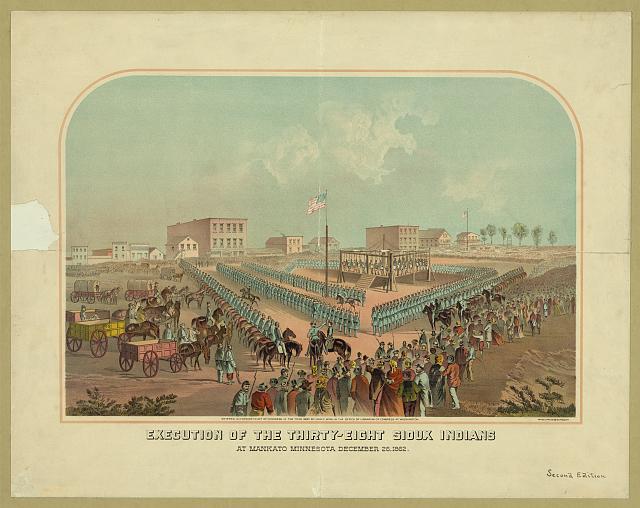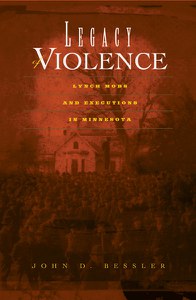 …The 1862 hanging of 38 Dakota men in Mankato MN following the U.S.-Dakota War. This war is a piece of history that was largely forgotten in the shadows of the Civil War (1861-1865). Its causes were complex, but besides the huge wave of new white settlers moving into Minnesota at this time, it was largely the result of broken treaties and promises. In 1858 the tribe entered into a set of treaties with the U.S. government which resulted in the Dakota losing most of their best hunting grounds. It also resulted in the Dakota becoming dependent upon the government for agreed-upon “annuity” payments of food and money. By 1862 the scheduled annuity had not been paid, and the Dakota were likely growing concerned that the Civil War had depleted the federal government of resources otherwise available to make the contracted payment. Besides feeling taken advantage of, the Dakota were also feeling crowded by growing number of settlers encroaching upon their remaining land, and were upset that government agents were failing to protect them as they felt they should. Some have theorized that as the Dakota were becoming aware of the growing north-south conflict of the federal government against the southern states, the most agitated of the tribe believed that the time was ripe to wage their own armed cause. The result was an attack on white settlements in the Minnesota River Valley, escalating into warfare that left nearly a thousand people dead. The federal government concluded this conflict by removing the entire tribe from the state of Minnesota, and publicly hanging 38 Dakota men in the town square of Mankato, a spectacle that was attended by thousands. You can read more about this event at MPR . In addition, a powerful documentary about a group horseback trek to undertaken in memory of this event is available for viewing on YouTube.
…The 1862 hanging of 38 Dakota men in Mankato MN following the U.S.-Dakota War. This war is a piece of history that was largely forgotten in the shadows of the Civil War (1861-1865). Its causes were complex, but besides the huge wave of new white settlers moving into Minnesota at this time, it was largely the result of broken treaties and promises. In 1858 the tribe entered into a set of treaties with the U.S. government which resulted in the Dakota losing most of their best hunting grounds. It also resulted in the Dakota becoming dependent upon the government for agreed-upon “annuity” payments of food and money. By 1862 the scheduled annuity had not been paid, and the Dakota were likely growing concerned that the Civil War had depleted the federal government of resources otherwise available to make the contracted payment. Besides feeling taken advantage of, the Dakota were also feeling crowded by growing number of settlers encroaching upon their remaining land, and were upset that government agents were failing to protect them as they felt they should. Some have theorized that as the Dakota were becoming aware of the growing north-south conflict of the federal government against the southern states, the most agitated of the tribe believed that the time was ripe to wage their own armed cause. The result was an attack on white settlements in the Minnesota River Valley, escalating into warfare that left nearly a thousand people dead. The federal government concluded this conflict by removing the entire tribe from the state of Minnesota, and publicly hanging 38 Dakota men in the town square of Mankato, a spectacle that was attended by thousands. You can read more about this event at MPR . In addition, a powerful documentary about a group horseback trek to undertaken in memory of this event is available for viewing on YouTube.
Minnesota is not currently associated hangings or executions, with capital punishment having been stricken from its books in 1911. Yet there was a time in Minnesota history that hangings and executions were not only front-page news, but public expositions garnering mass attendance. This is one point behind John D. Bessler’s Legacy of Violence: Lynch Mobs and Executions in Minnesota. In addition to the mass hanging described above, Bessler details Minnesota’s most controversial and attention-grabbing executions.
